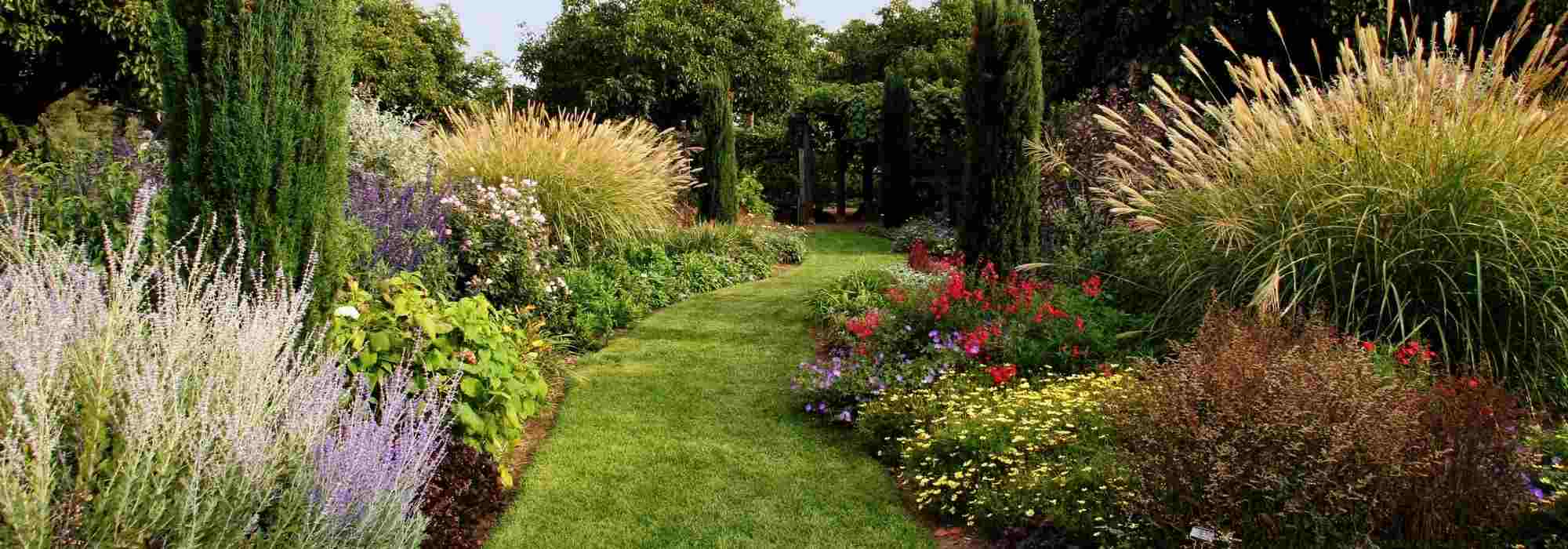
The English garden mixed border
The English charm of extra-large flower beds
Contents
The mixed border is often mentioned without a clear understanding of what it truly entails. This English term has never been properly translated into French and is used interchangeably in both masculine and feminine forms. It actually refers to a wide flowerbed where blooms are mixed with a focus on colour harmony, in a display of free and natural habits. Beyond being a simple mass of opulent perennials, it sometimes also includes bushes, forming several strata, and generally takes an elongated shape, either along a wall or as two elongated beds mirroring each other around a lawned path.
How to create a mixed border? What plants make up a mixed border? We invite you to take a little tour of the English garden to equip yourself with the essential keys to know before embarking on this romantic mixed border… so British!
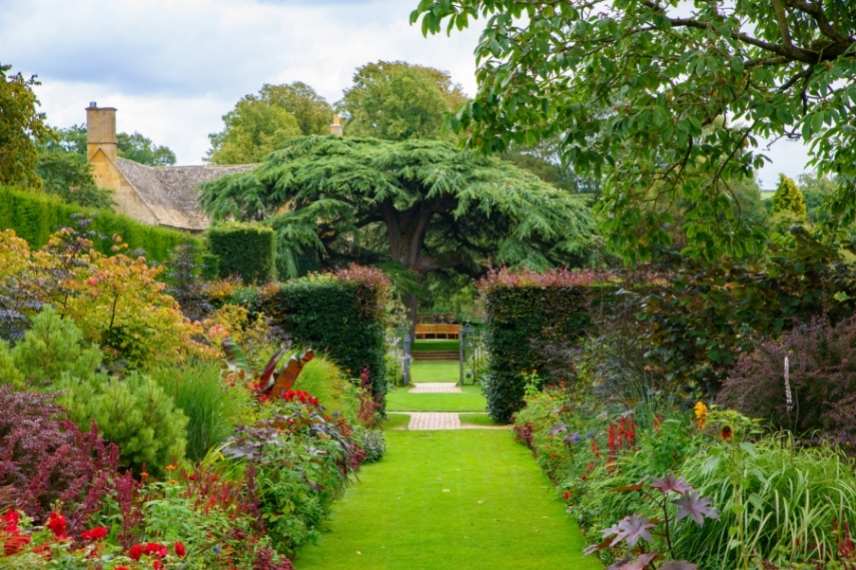
The ‘Red border’, an exceptional mixed border at Hidcote Manor, England
The origins of the mixed border
Iconic of English gardens, the mixed-border is inseparable from the romanticism of English-style gardens, playing on the remarkable combination of opulent flowerings and a harmonious blurring of shapes. It emerged around the mid-20th century and is associated with the high priestess of the English garden, Gertrude Jekyll (1843-1932), who established the informal garden.
This exceptional landscape gardener created gardens primarily in England, but also in France and Europe, featuring large flower beds where the mix of flowers and foliage intertwines in a controlled manner, with no plant overshadowing another. Composed mainly of perennial plants, bushes, as well as some annuals and bulbous plants, along with grasses, the mixed-border offers a riot of colours and volumes in a highly developed abundance. One understands, when one examines the multiple precise plans of this great lady, that these enormous masses are ultimately very structured despite the natural image they project to the passerby.
In contrast to the formality of a structured French border, the mixed-border represents the culmination of a profusion where colour plays against light and notions of perspective. From the irregularity of volumes and shapes, a harmonious and very natural space is born, bursting with colours in summer.
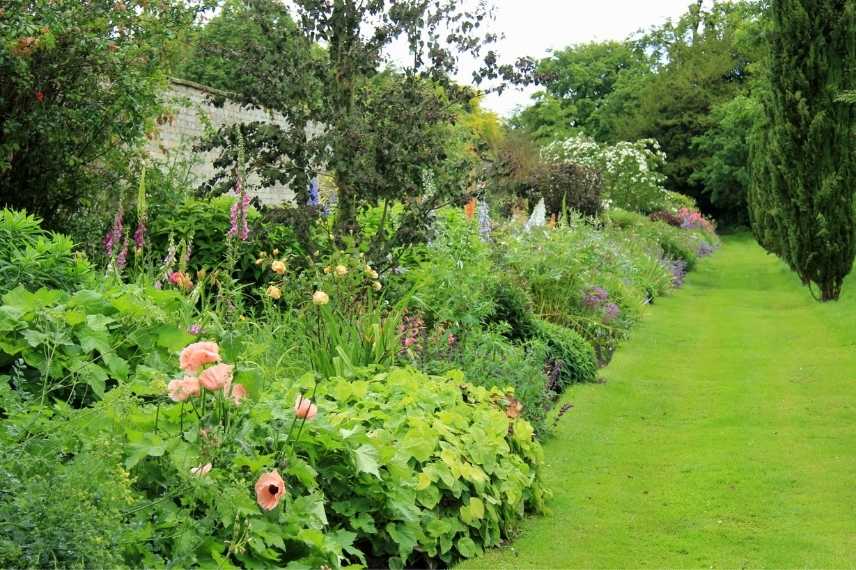
Chippenham Gardens mixed-border (© Karen Roe)
Read also
How to landscape an English garden?The principles of the mixed border
The mixed border has some unique characteristics:
- The importance of colour: plantings are irregular, often repeated, and organised according to a chromatic theme: colours in pastel shades in an impressionistic style or, conversely, the use of vibrant colours, or even two complementary colours from the colour wheel: the play of warm and cool colours has been a significant source of inspiration and work for Gertrude Jekyll. She typically composed a pattern starting with soft colours and silver foliage, then a clever association of bright colours building to a crescendo, finishing again with soothing colours. The use of white and grey foliage always serves as a binding and balancing element.
- A skillful mix of predominantly herbaceous perennials, woody shrubs with a rather flexible silhouette, annuals, and bulbous plants to fill in the gaps between seasons and ensure a long-lasting effect.
- The size of the mixed border is impressive and contributes to its splendour: at least 2m, often 3m wide, expressed over a great length. At Munstead Wood, the mixed border is 60m long, the one at Wisley Gardens is also renowned (128m long), while the most impressive remains that of Darleton Castle in Scotland, measuring 215m!
- Thoughtfully designed volumes to create taller backgrounds or mid-levels in the bed. Several strata are used to create a relief that remains soft: upright perennials, mid-height shrubs in the background, soft grasses and groundcovers in the foreground.
- A majority of hardy plants to ensure longevity across seasons and years.
- Rectilinear and rectangular in shape, the mixed border runs alongside a path, sometimes featuring more curved lines. It is primarily found in the form of two long flowerbeds facing each other in English and French gardens. They are often leaning against a wall or a neatly trimmed evergreen hedge to highlight the vibrancy of the flowering.
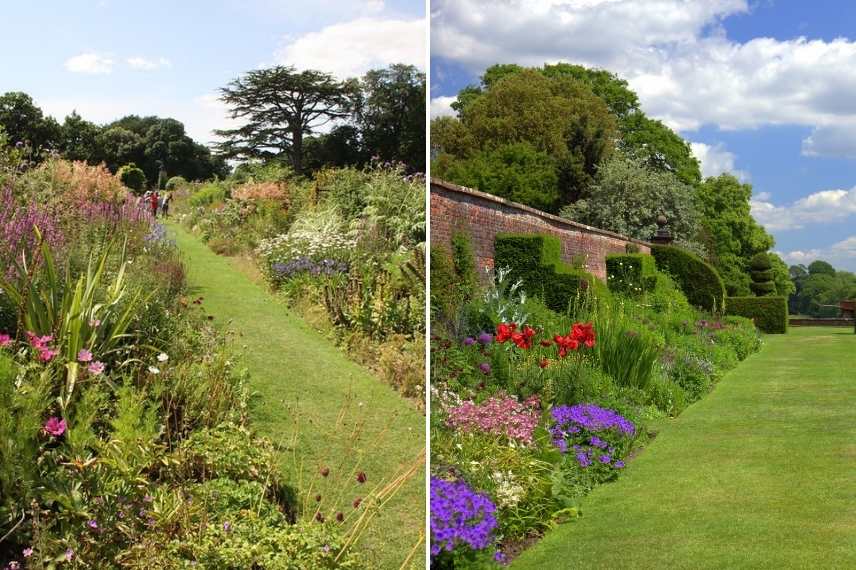
Mixed borders at Helmingham (left, © Dave Catchpole) and Arley Hall on the right
What plants make up the mixed border?
The mixed border can incorporate a multitude of plants, which is its great strength. It also relies on a composition made of repetitions for a harmonious effect and to avoid a cluttered jumble. It is advisable to install plants of varying heights and volumes to achieve an ornamental visual.
Composed mainly of perennial plants, but also grasses, the chosen species should be as airy and free as possible. It’s impossible to list them all, but here are a few suggestions:
Perennials
Many medieval garden plants and cottage garden plants, for full sun or partial shade: Achilleas, Delphiniums, Nepetas, Echinaceas and Heleniums, Euphorbias, Agapanthuses, Penstemons, Aconites, Oriental poppies, Phlox, Anthemis, Lupins, Campanulas, Eryngiums, Fennel, Asters, Veronicastrums, and among the bulbous plants: Irises, kniphofias, Alliums, Cannas, Fritillaries, Daylilies,… Cooler soils will see Filipendulas, Libertias, Wastonias, Ligularias, and other Eupatoriums thrive… Annuals like Cosmos bring an unparalleled lightness, while Cynara cardunculus, which are structural, are enhanced at the back or middle of the border.

Irises, Coreopsis, Echinops, Alstroemeria, Delphinium, Dahlia, Eremurus among a wide palette of perennials and bulbous plants
Shrubs
We focus on soft and natural habits, shrubs with strong personalities, and contrasting foliage colours, such as Cotinus coggygria, Exochorda racemosa, Perovskias, Abelias, Physocarpus opulifolius, Spiraea japonica, purple Berberis, Winged Euonymus, varieties of Cercidiphyllum or Parrotia, Ceanothus, etc. For a taller stratum in very large mixed borders, a beautiful Catalpa bignonoides, Cornus, Buddleias, as well as evergreen coniferous foliage can be integrated… Botanical roses certainly shine in the romantic mixed border.

Cotinus coggygria, Exochorda racemosa, Miscanthus, Physocarpus opulifolius, Spiraea japonica
Groundcovers and beautiful foliage
They are very useful in the mixed border to fill gaps and bring beautiful foliage, especially when they venture onto the path gracefully overflowing. They are chosen to be mainly evergreen and flowering in association with the rest of the border: Bergenias, Heucheras, Aubrieta, Ajuga reptans, Alchemilla mollis, the blue or variegated Hostas, Geraniums, Stachys, Hebes, Cistus, as well as the remarkable foliage of Hakonechloa and Ophiopogon.
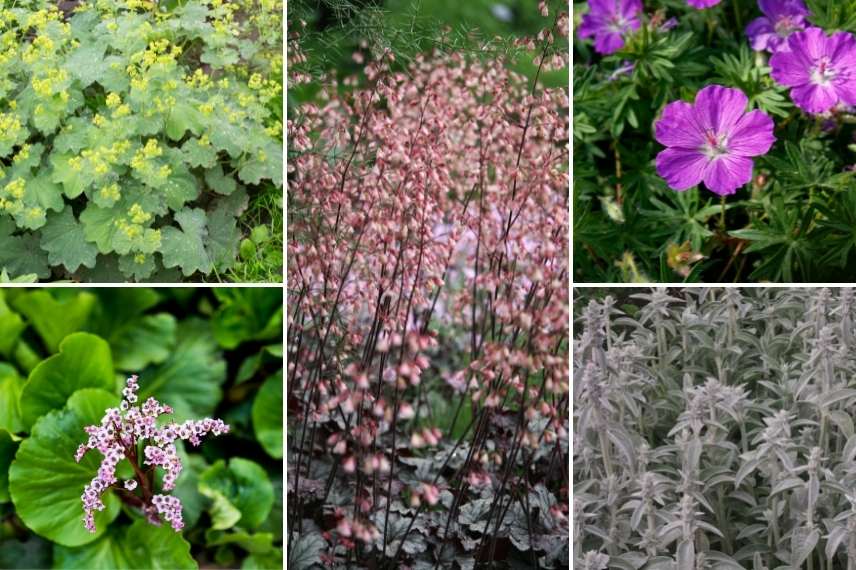
Alchemilla mollis, Bergenia, Heuchera, Geranium sanguineum, Stachys
Grasses
In a large space, they are generous at the back with Miscanthus, Calamagrostis, Molinias, or Panicum for example. The grasses take over in autumn until winter, where they ensure a beautiful presence. Some low grasses are also perfect for weaving into the mixed border (Carex, Pennisetum, Fescues, Sporobolus…).
The advantages and disadvantages of mixed borders
The advantages of a mixed-border are numerous:
- A very rich palette of plants
- Possible arrangements in many garden styles, exposures, and climates by adapting the plants
- The constant possibility of changing certain plants if they haven’t thrived, or replacing them to refresh the area after a few years
- An interesting “volumetric” effect for flat gardens, a proven groundcover effect over a large area, etc.
- A beautiful space from spring to autumn, peaking in mid-summer
- The natural and lush impression, the scale and abundance fits well with the trend of naturalistic gardens.

Blue and mauve mixed-border
However, there are some disadvantages or difficulties:
- The main difficulty lies in the planting plan as it is not always easy to envision the space each of the lush plants will occupy in such a large volume. It is important not to plant too closely, which one might be tempted to do to achieve a visually pleasing result quickly.
- The mixed-border is less attractive in winter and early spring, being very much associated with summer
- It is primarily used and excels in large gardens
- The insertion of bushes should be limited and balanced to prevent them from taking up too much space as they grow, limiting the lush effect of summer perennials
- The colour scheme should be considered in relation to the rest of the garden if it is of a smaller size
- Large mixed-borders will need to be adapted to more modest dimensions in small gardens (the notion of plant repetition will be lost)
- A northern exposure is less conducive to the profusion of colours on which the mixed-border relies. However, it is still possible to bring the mixed-border into a shaded garden, which will then rely on white, pink, and blue tones.
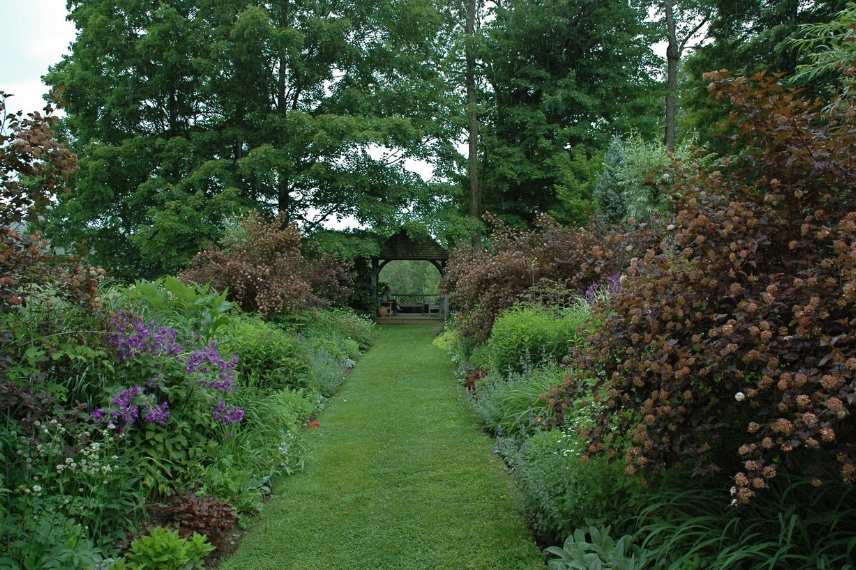
Private garden, Hayward gardens – Vermont, USA (© Putneypics)
How to maintain a mixed border?
Considered difficult to maintain as it requires regularly dividing plants that have become too comfortable, and trimming the mass of flowers, the mixed border also has the advantage of providing plenty of flowers for making bouquets. Regularly cutting the flowers is therefore one of the best ways to effectively maintain this space. Let’s be honest, transplanting is one of the tasks that gardeners must undertake in the mixed border to keep it within ideal volumes and proportions. And the larger it is, the more time this task takes… so if this intimidates you a bit, reduce the size of the flower bed.
The bushy and abundant effect should spare you from weeding, especially if you take care to mulch generously.
A drip irrigation system will be essential for large mixed borders, or for water-hungry plants like Dahlias. Again, it is useful to think ahead about drought-resistant plants if you cannot install an effective watering system.
Finally, supports are sometimes necessary to hold up tall stems (romantic wooden or metal obelisks are perfect in this type of space).

Mixed border at Wisley Gardens, October (© Mark Flickr)
A few examples...
Of the 400 gardens created worldwide by Gertrude Jekyll, very few have survived, with only some being skillfully restored, often featuring exceptional mixed-borders, a hallmark of the English landscape designer.
Among them is Munstead Wood in Surrey, her home and first experimental ground. Also included are Hestercombe Gardens, Woolverstone House, and Upton Grey Manor House (southwest of London), as well as the charming little garden at Lindisfarne Castle in Scotland, along with Hascombe Court (in Surrey).
In France, the Bois des Moutiers in Normandy is famous for having employed Gertrude Jekyll in its design. A beautiful mixed-border faces the house on the south side.

The extraordinary and famous mixed-border at Dirleton Castle (© Aly 1963)

Mixed-border at Bois des Moutiers in France (©Amanda Slater)

A vibrant mixed-border in shades of mauve in full summer at Savill Gardens (© Mark Flickr)
Learn more
- Discover our range of mixed-border plants in our online nursery!
- Here is the official site of the great English lady of gardens, Gertrude Jekyll: this site is in English only, but it is of great interest to anyone interested in her journeys, gardens, and books.
- Subscribe!
- Contents
































Comments